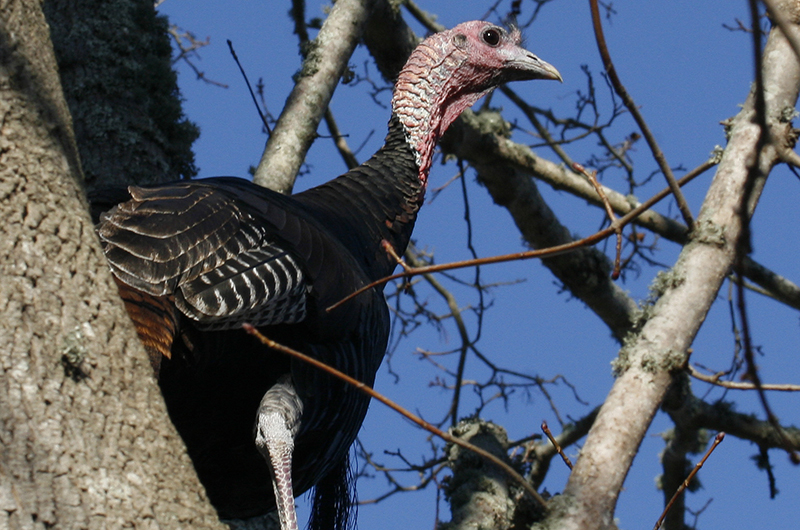Christmas Bird Counts are fun days, combining camaraderie, teamwork, and adventure as we search the land and sea for all the birds we can find. One testament to how much fun the count is: people return to participate year after year, for some even decade after decade. Some counts, however, are more challenging than others.
Saturday, Jan. 5 was the day for the 59th annual Martha’s Vineyard Christmas Bird Count. All week the weather forecasts had called for rain that day, and all week we hoped that the forecasts would be wrong. But they were correct. It was a washout as it seemed like it rained/misted all day. At around 10:30 a.m. we thought we saw the sun, however briefly, through a slightly thinner and lighter gray cloud. People have described this weather as: “At least it was good for the ducks!”
I started early, about 1 a.m., with the hope of hearing owls calling before the rain started. The strategy paid off with three owls calling from different locales, each a different species. Most amazing was the barred owl; a new species for the count although it has been hanging out in Edgartown near Sheriff’s Meadow Sanctuary for 1.5 years. There it was, perched on the bike rack, mouse in beak, caught in my headlights as I drove up to the parking lot. A little luck goes a long way. A great start to the day.
After a few more hours of sleep, I met my teammates, John Clark and Kenny Ivory, at the regional high school at 6 a.m. Yes, in the rain. It was still dark and raining when we got to Long Point, but at first light we walked down the beach to the opening. Dense fog lay a couple of hundred yards offshore, but there were no birds on the ocean, and only a few bufflehead and gulls were on Tisbury Great Pond. I have never seen this area so devoid of bird life.
The scarcity of birds continued even after we ventured off the beach and into the woodlands up the road to near the head of Deep Bottom Cove. It was not until 9 a.m., after about an hour in the woods finding only blue jays and crows, that we finally got our first black-capped chickadees. There were five of them, and also five red-breasted nuthatches. Everybody enjoys seeing these two hyperactive species. There were also some ducks scattered along Deep Bottom Cove, although they were nowhere near as abundant as they usually are. Things were looking up.
Around 10:30 a.m. the skies brightened, buoying our hopes that we might finally start finding birds. We visited a favored thicket near Flat Point Farm. I played my recording of chickadees mobbing a calling screech owl, and almost instantly we were surrounded by 25 black-capped chickadees. A catbird and two rufous-sided towhees also popped out of the brush as well. Finally, we were on a roll.
No such luck, as the frostbottom near Coffin’s Field produced no birds for us. Last year we found 14 towhees in this area. The next few hours produced few birds, even though there was only a misty light rain. Our lone highlight was a female wood duck (the only wood duck found on the count) that was in a flock of mallard near the canoe slide at Sepiessa Point.
It was now around 2 p.m. and starting to rain harder. We were along the northern part of Watcha Pond, where there are always birds. But there were none. We walked along the edge of the pond and found a place protected from the increasingly strong northeasterly winds. Two yellow-rumped warblers were found, and then a rather wet and bedraggled phoebe popped out of the shrubbery, only 200 yards south of where we found one last year (in good weather). Then there was motion around the base of the flooded shrubs at pond’s edge, and a male common merganser left his hiding place and swam out onto the pond.
Those were just about the last birds we saw. The fact that ducks were hiding in the shrubs suggests that even ducks do not care for this weather.
Many of the birders met at 5:30 p.m. at the Wakeman Center. The camaraderie at the tally was contagious as everyone shared their adventures of the day. We then compiled the results of our efforts. All the teams reported lower than usual numbers of birds, but interesting stories were told.
The preliminary results are that we found only 112 species and we counted 16,548 individual birds. This was the third lowest species count since 1980, the year we started including the entire Island rather than just a prescribed 15-mile diameter circle. The only lower species totals were 100 species observed in 1990 and 106 species observed in 1992. Only once since 1980 have we counted fewer birds when 14,123 individuals were counted on the previously mentioned 1990 count. I bet it was bad weather for both of those counts too.
I will have more details about the species highlights of the count in next week’s column, after compiler Luanne Johnson irons out a few more issues with the data.
A few of our winter residents are still showing up even though daylight is now increasing. Please report all your sightings to birds@mvgazette.com.
Robert Culbert will schedule a private Guided Birding Tour with you, and is an ecological consultant with Nature Watch, LLC living in Vineyard Haven.






Comments
Comment policy »